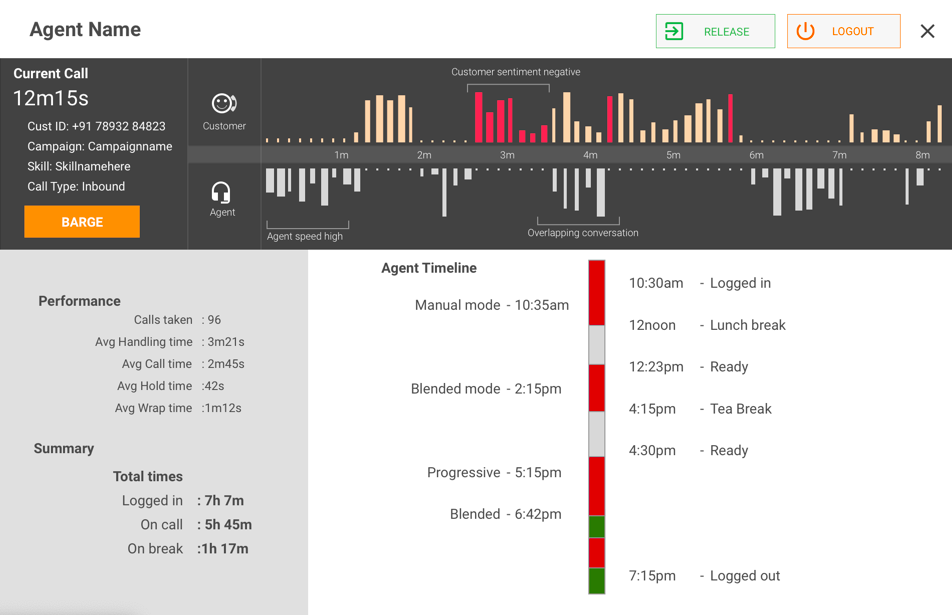Real-time speech analytics is here. Learn how it changes the way managers can measure and improve call center performance.
Your team is working hard, logging in hours and hours, speaking to hundreds of customers every week. As a contact center manager, can you listen in to every single call that’s taking place and evaluate it for agent performance and quality? Probably not. It is more likely that you get to know about angry conversations or dissatisfied callers long after the call takes place. Or (worse!) you may never hear about them, at all.
Even if you have a quality assurance team sifting through call recordings for agent and contact center performance, it’s unlikely they’ll be able to cover more than 10% of your total call recordings. So how can you keep track of it all, and improve those conversations? Technology can help.
Get ready for whole new performance metrics
Intelligent features like Speech Analytics can help you evaluate and gather information from every single call in a matter of seconds. This means that you can not only monitor every single call that takes place in your call center, you also get live updates. In other words, you monitor every single call and are alerted to problems, not after the event, but while they are taking place.
What is Speech Analytics?
Speech Analytics is a tool that analyses speech data for specific information and patterns. Businesses can use speech analytics to find marketing and business insights from their call recordings. And call center managers can use it to deliver better customer experience. Ozonetel uses AI-powered solutions to extract information in real-time. This allows call centers to deliver a better customer experience and also enhance agent performance.
What insights can Speech Analytics give Call Center Managers?
AI Speech Analytics features make it possible to automatically get comprehensive insights plus data summaries on your supervisor dashboard. Here’s a peek into what our new SA enabled user dashboard looks like. You can, of course, create different dashboards to suit your needs. Or create dashboards for your agents to gauge and improve their own performance in real-time. You can also set up alerts that get sent to your phone or email id.
1. Conversation Speed
Clarity and enunciation play a huge role in voice communication for customer service; this is where an ideal talking speed (or range) comes in, often measured in words per minute (wpm). For example**:
Speech rate guidelines according to certain studies:
- Slow: Less than 110 wpm
- Conversational: Between 120 wpm & 150 wpm.
- Fast: More than 160 wpm
Speech rate varies not just across languages and dialects, but can also be affected by gender, culture, and purpose and one needs to tweak speech speed to communicate better with customers.
Get insights into the speech rate for each individual agent with the Agent Speed analytics and whether they are hitting the right balance. This feature can also be added to each agent’s dashboard to help them see if they are talking too fast or slow.
2. Conversation Volume
In order to address a customer’s query, an agent must be audible. But more importantly, the volume at which they speak can indicate how the call is going. For instance, a raised voice may indicate conflict. In such cases, you can set up real-time alerts for supervisors to barge in and take over calls. At the same time, customers can get extremely irate if an agent raises their voice, you can “whisper” to them to stop or set up automated alerts or indicators. Dissecting these calls and the volume and/or tone spikes helps also weed out words, phrases, and specific issues that are causing the negativity.
3. Customer Sentiment
AI-based analytics can automatically gauge customer sentiment during a call. You can find out, for example, if the customer sentiment started out negative and ended positively, and use this to assess agent performance. The customer sentiment dashboard can also help you get a pulse of the overall customer sentiment in your call center. And take action on unusual changes.
4. Customer Demographics
Knowing certain customer demographics like gender can be a useful tool in business and demographic analysis, gauging whether to tweak your communication tactics and modes, as well as other business activities like sales and marketing. (Stay tuned, more on that to come later!) Speech analytics can also be incredibly useful for insights into customer behavior and purchasing trends.

A sample view of a Speech Analytics Dashboard. The graph on top shows the speech data for the current call. The volume is indicated by the height of the bar, and the speed is shown in the thickness of the bar.
Future Uses of Speech Analytics
According to research* by Deloitte Insights “A key to fostering more productive reflection is to identify and implement faster, and richer, feedback loops to get internal and external feedback on a recurring basis. Workgroups should look for opportunities to establish feedback loops that help members understand what the customer expects or needs and where they stand relative to that.”
Speech Analytics gives you new ways to measure agents’ performance. Adding a speech analytics dashboard for agents can give them immediate feedback. They can view their speech rate, volume, keyword usage and change the way they speak immediately.
Conclusion
Thanks to Speech Analytics, enhanced customer experience, and elevated agent performance are now within much closer reach. Start thinking about what insights and alerts you want from your call center. Having them at your fingertips is now easier than ever.
References:




